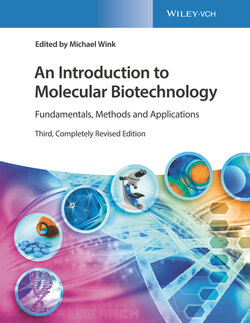Читать книгу An Introduction to Molecular Biotechnology - Группа авторов - Страница 50
5.3 Protein Transport into the Endoplasmic Reticulum
ОглавлениеIn electron microscope photographs, the rough ER is recognized by its large number of ribosomes, which look as if they are tightly bound to the ER membrane (Figure 1.2). These ribosomes are in the process of synthesizing proteins, which are then secreted into the ER lumen. These proteins are characterized by a specific signal peptide in the N‐terminal (Table 5.1).
In principle, protein biosynthesis begins on the free ribosomes in the cytoplasm. When a protein exhibiting an ER import signal peptide is synthesized, a signal recognition particle(SRP) will bind to the signal sequence. In the next step, SRP binds an SRP receptor present at the ER membrane and therefore brings the translating ribosome into the vicinity of a protein translocator(consisting of Sec61, 62, 63, 71, and 72). Figure 5.5 schematically shows the import of a protein into the ER lumen. As soon as a protein is completely synthesized and the C‐terminal of the protein has arrived in the ER lumen, a signal peptidase cleaves the signal recognition sequence, and the protein is freed into the ER lumen.
Figure 5.5 Simplified scheme of the import of a protein into the ER lumen.
The import of membrane proteins is similar. The growing polypeptide chain is internalized until a second signal sequence, which corresponds to a transmembrane domain, is reached (Figure 5.6). The cleavage of the first signal sequence results in a transmembrane protein with a transmembrane region. The C‐terminal lies in the cytosol and the N‐terminal in the ER lumen. The formation of membrane proteins with many transmembrane regions occurs in a similar way. Some proteins (including SNARE) are anchored in the ER membrane by a C‐terminal hydrophobic α‐helix.
Figure 5.6 Simplified scheme of the integration of a membrane protein into the ER membrane.
Proteins that remain in the ER and are not channeled out through the Golgi apparatus have a retention signal at the C‐terminal. Such ER proteins serve, among others, as chaperones. Misfolded proteins are exported into the cytosol where they are degraded by the proteasome.
Upon entry into the ER, most proteins that are to be exported are coupled with an oligosaccharide residue. An oligosaccharide is linked to an asparagine residue via an N‐glycosidic bond. Oligosaccharides with 14 sugar residues (above all those containing N‐acetylglucosamine, mannose, and glucose) are present as dolichol diphosphate esters in the activated form, in which the lipophilic dolichol residue is anchored in the biomembrane (Figure 5.7). Also present in the cell are glycoproteins whose sugar residues are linked to threonine or serine with an O‐glycosidic bond. Their synthesis occurs in the Golgi apparatus and not in the ER. The sugar residues are altered again in the different compartments of the Golgi apparatus, where they obtain their final specificity.
Figure 5.7 Assembly of glycoproteins in the ER. The oligosaccharide exists as a dolichol diphosphate ester in its activated form and can be transferred onto an asparagine residue of the growing peptide chain.
A few proteins are associated with the cell membrane. This usually occurs through a glycosylphosphatidylinositol(GPI) anchor, which can be attached to the C‐terminal of a protein.
